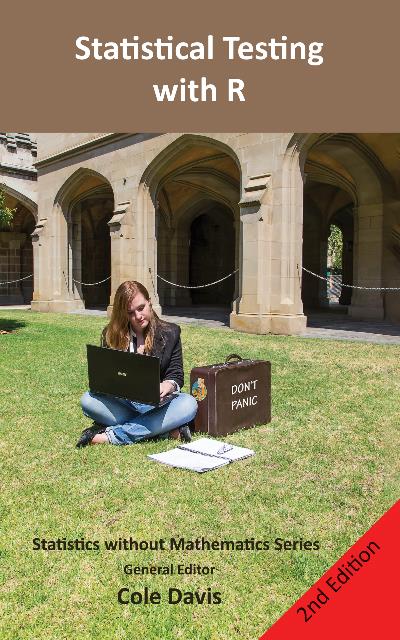|
| Home |
| Order books |

|
Statistical Testing with R
Statistical Testing with R
Exercises and case studies
Chapter 9 in the book contains basic exercises covering all of Section 2. Diverse tutors, however, have asked for traditional chapter by chapter exercises, hence the table immediately below. Further down the page, case studies are presented for readers who have finished reading the whole book, or their tutors.Exercises
These chapter by chapter exercises have been contributed by Marianne Vitug. For each chapter is a document with the questions, and one with the answers, with relevant spreadsheet files (with the .csv suffix). Each page opens in a new tab of your browser.
| Ch 2 Research design | Questions | Answer | self-entry |
| Ch 4 Descriptive statistics | Questions | Answers | data file 0 |
| Ch 5 Inferential statistics | Questions | Answers | data file 0 |
| Ch 6 Tests of differences | Questions | Answers | data file 1 |
| Ch 6 Tests of differences | data file 2 | ||
| Ch 6 Tests of differences | data file 3 | ||
| Ch 6 Tests of differences | data file 4 | ||
| Ch 7 Tests of relationships | Questions | Answers | data file |
| Ch 8 Categorical analyses | Questions | Answers | data file |
| Ch 11 Factorial ANOVA | Questions | Answers | data file 1 |
| Ch 11 Factorial ANOVA | data file 2 | ||
| Ch 11 Factorial ANOVA | data file 3 | ||
| Ch 14 MANOVA | Questions | Answers | data file |
| Ch 15 PCA and factor analysis | Questions | Answers | data file 1 |
| Ch 15 PCA and factor analysis | data file 2 | ||
| Ch 17 Cluster analysis | Questions | Answers | data file |
| Ch 18 Logistic regression | Questions | Answers | data file |
| Ch 19 Survival analysis | Questions | Answers | data file |
| Ch 20 Partial correlations | Questions | Answers | data file |
| Ch 22 Bayesian statistics | Questions | Answers | data file |
Case studies
You have a selection of different measures derived from studies of bullying at school. Are there different types of bully?
You are interested in the views of members of the public on trafficked persons. The data has been derived from a large number of questionnaire items.
You have a wealth of quantitative data on attitudes to migrants. You believe that people have specific ideas about the impact of migrants on the labour market, their role in the sex industry and the nature of victimhood.
Do people who suffer severe psychological stress after loss of a loved one have different psychological characteristics from those bereaved people who do not require treatment? You believe that age, ethnicity and gender may also affect the classification.
Is a type of counselling likely to differ in its effectiveness depending on the type of presenting problem? For example, if we used cognitive-behavioural therapy, would it have very different effects on people whose main symptoms were alcoholism, gambling addiction and panic attacks? Age, ethnicity and gender may affect the classification.
You are interested in the willingness of people to leave money to charities. Which psychological attributes lead to large, medium and small bequests? You may wish to consider attributes such as the number of close relatives with a related condition or experience, the age and social class of the respondents.
Which characteristics typify different levels of police officer? Include gender and other demographic data as well as measurable attributes.
You are interested in the effects of caste reforms in India, particularly in its effects on long-term unemployment. How would you contrast different castes, or areas with different ways of doing things?
We are interested in longevity among Russian males. What might be the simplest way of examining this?
Are schoolchildren in ability groupings more likely to perform academically than those in mixed ability groupings. Does gender have a part to play?
Recruiters were shown functional resumes (Brits: cv's) and asked to rate them in terms of employability. The documents had different skills levels, with photographs of differing levels of attractiveness and differing age groups.
Students in a state's police academy have over the years found certain statutes on domestic violence to be very difficult to understand. Over the year, two sessions with somewhat different teaching methods are tried: one focuses most on case studies, while one pays more attention to the legal principles involved. The sessions are in fact held four times, so that half the students get to use the case studies first while the other half do legal underpinnings first, each attending the other session later.
Statistics without Mathematics series - General Editor: Cole Davis
ISBN numbers: Hardback - 978-1-915500-01-4 Paperback - 978-1-915500-00-7
Ebook - 978-1-915500-02-1
